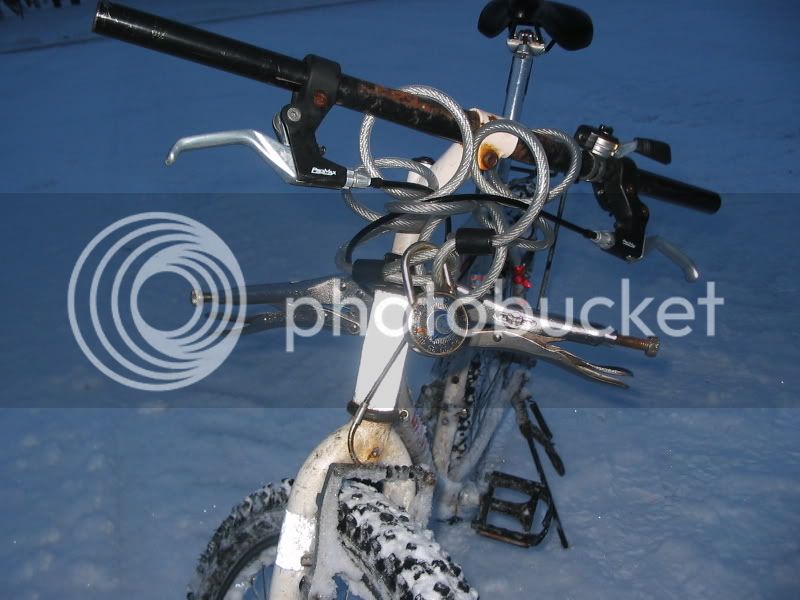From:
http://www.ducatitech.com/bbs/viewtopic.php?p=2051&sid=61370fa8893e41c9a2023df52bc945de
The argument that won't die: can you ride a bike without countersteering?
of course you can, its called 'no-hands' but whats the relationship between so called "body steering" and counter-steering the handlebars?
Keith Code has made quite a lot of fuss about this, apparently he has students who don't believe in countersteering.
Anyway, whatever you think of KC, here's a definitive explanation from Tony Foale:
Quote:
...In short: When you move your CoG to the left, the bike must lean to the
right to compensate, this creates a camber force at the tyres to move the
tyres to the right, this is similar to counter-steering except that it is
much weaker. These tyre forces to the right rotate the bike back to the
left resulting in a left turn. There is no doubt that we can ride no-hands
and perform gentle turns, this is done by body movement. The thing to
remember is that this effect is much less than that obtained by
steering. FF riders will atest to the fact that they can steer quite well
with virtually zero body movement, but I doubt that anyone would suggest
that we can steer well with only body movement.
Regarding "peg weighting", this topic seems to generate all sorts of weird
explanations requiring a very strange version of Newtonian physics for
validity. Some people seem to assume that one can increase the load on one
foot-rest without any other changes. Of course this is impossible, to
increase the load in one place requires that load is lessened in
another. Peg weighting as such is a red herring. What is important, is
the location of the rider's CoG and the rider applied steering
torque. Because we have so many points of contact with the bike, (2 hands,
2 feet, 2 knees and the seat) it is possible to achieve a given CoG
position and steering torque by many different combinations of forces at
these contact points. So peg weighting is really a question of one
particular riding technique used to achieve this. Other combinations of
hand, foot, knee and seat forces could produce the exact same effect on the
bike. If we only had 3 points of contact with the bike then a given CoG
position could only be achieved by ONE set of forces at those points.
As for myself, I agree entirely with Frank, when he said "I guess that I
just learned to ride and never thought about it for 40 years. If it works
why worry about it."
......
------------------
Regarding Code's NoBS bike, to avoid re-writing stuff the following is from
some earlier correspondence that I had on this subject, with a couple of
people who have ridden it.:
<<
Dave,
I found your experiences with the No BS bike interesting, but slightly
unconvincing.
Don't get me wrong, I totally agree that counter-steering is by far the
predominant factor in steering and body movements have a relatively minor
effect. Neither am I suggesting that you didn't observe what you claim, I
have no
doubt about this.
What I'm unconvinced about and I'm sure that you must have some reservations
also, is that we can ride, balance and steer to a small extent by riding
no-hands. We know this to be fact.
However, it seems to me that the No BS bike indicates the opposite, it is
harder to ride than with no-hands. Therefore, there must be something
non-technical with the No BS bike that is going on. It has to be in the
rider's head. You have the advantage over me here, you've ridden it and I
haven't. What I'm guessing is that when we ride no-hands we expect to
control the bike only by body movement and so we adjust our movements
accordingly. With the No BS bike, the rider still holds on to "normal"
bars, but nothing happens when he applies his intuitive responses to control
the bike, does his psychic then get short-circuited and react
inappropriately?
Something like this must be going on, because all the reports that I've seen
seem to indicate that the No BS bike is harder to ride than it is to ride
no-hands.
There are three fundamental modes of instability inherent in a bike layout.
Viz: Wobble, weave and capsize. The capsize mode is what you describe when
discussing the decreasing curve of the No BS bike. This is a well
understood phenomenon and can be seen by pushing a bicycle and letting it go
on it's own, it will start to circle with a decreasing radius until it
crashes.
However, as long as our speed is high enough we can stabilize
this capsize tendency even when riding no-hands. So obviously the NO BS
bike causes the rider to alter his response from the no-hands case. This is
an age old problem with designing experiments, that every scientist knows
about, does the experimental method itself change what we are trying to
observe. In this case I fear that it does.
In the 1960s. I did a lot of funny experiments to collect data to validate
some mathematical models that I'd developed. One set was to investigate
riding without steering by hand, these were different from Code's in that
there was some
movement in the handlebars even though they didn't steer. My recollection
is that it was harder to ride than with no-hands but it doesn't sound like
it was as hard as with the Code machine. Just guessing but maybe the "give"
in the handlebar movement didn't confuse the rider (me) to quite the
same degree as completely rigid bars. My first experiments had completely
free handlebars and I remembered that these were hopeless, I just turned
them through totally excessive angles which unsettled my riding completely.
I then included a torque measuring device and this is what allowed only some
rotation. I never did it exactly as per Code. Now I wish that I had.
---------------------------
Other correspondence.
I've had some correspondence with DH on this topic, as I'm sure you
know he's ridden the No BS machine also.
I think that we agreed that riding the No BS bike is not the same as riding
no hands. We all know that when riding no hands we can initiate (and
control reasonably well) a gentle turn. There is no technical difference
between the No BS and riding no-hands so the difference must be in the mind
of the rider.
I think that when riding no hands we only expect to input commands via body
movements and so that is what we do, and it works to a small extent. On the
otherhand when riding the No BS I think that the rider will still
subconsciously expect some response from hand input, when none comes, his
brain is likely to be confused and not really capable of directing the
required body movements that he would if riding no-hands, with the result
that the bike appears to be less controllable than it really is.
Humans are quite capable of allsorts of difficult control feats but we are
also very easily fooled.
I think that Code has inadvertently made the classic error of experimental
investigation. The experimental method affects the results.
I've experimented with a wide variety of control layouts on both motorcycles
and bicycles and some results have been quite surprising.
When planning the design of my QL in the early eighties, it occurred to me
that for packaging reasons some vertical "joy sticks" would be useful
instead of the normal fork top ones pivoting about an approximately
vertical axis, (the QL wasn't going to have forks so there would be no
natural place to put them anyway), so I made some test examples and fitted
them to my hack boxer which was well used to being used for all sorts of
experiments. You can see from the attached pics. that the machine appears
perfectly ridable. However, very few people could actually ride it.
Several would just fall over within the first metre, others would struggle
to move off and wobble about slowly and give up. Yet others like Terry in
the pic. and I could just get on it and ride off relatively normally without
real problems.
Later I lashed up a vertical dummy headstock and installed handle-bars which
pivoted about a vertical axis, although I still kept the upright hand grips
(that's another story, but they are much more comfortable than normal
grips).
The only difference between these two sets of handlebars as far as
interfacing with the rider was concerned was that the hand grips moved
through SLIGHTLY different loci, for the small amount of steering that we
normally use for straight riding. Yet the difference to the rider was
incredible, nobody any longer had any problems riding the bike, I'd ridden
with the "joy sticks" almost exclusively for two months and it felt quite
normal to me, but even I felt far more confident.
The joysticks had the weird effect on a lot of people to the extent that
they appeared to lose all intuition to countersteer at low speeds, but those
that managed to get above about 10 mph would then revert to countersteering
normally????????????
A year or two back I built a long wheelbase recumbent bicycle. As the head
stock was a long way in front of my hands I obviously had a whole load of
options on how I could connect to the steering. So with the benefit of the
above and other past experience, I thought it wise to design a test
programme and try a range of different possibilities within 3 main groups.
Firstly, I just brought a bar backwards from the forks and then at my hand
area had a normal across the frame handlebar, so the handlebar action was
more sideways than turning. (tiller action) With this setup I was able to
ride it immediately but not easily, after a week of riding it I was still
quite wobbly on it.
The 2nd. group of tests used a roughly horizontal steering column, rather
like in a car. I had great difficulty actually riding this, I had to
practice for half an hour each day for a week before I could go on the road.
I found that if the column angle was laid back from the vertical by more
than about 45 degrees, then it was hard to control, less than 45 deg. and it
seemed OK. I think that when the column was set low, it told my brain that
it was a car and so I didn't countersteer.
Thirdly I made a second headstock about 2' back from the real one and
mounted handlebars on that, which connected to the forks via a drag link.
As I expected (hoped) this felt exactly right and there was zero learning
period involved.
I mention these experiences because although different from the No BS bike,
they show just how easily our senses can get confused. Technically, the
only difference between my various tests was how the steering interfaced
with the rider. If the rider applied the appropriate handlebar movements
then the machine would have reacted the same. So these machines should have
been much more ridable than the No BS but sometimes weren't. It seems that
a fixed handlebar makes the No BS bike APPEAR less rideable than it would be
no-hands, whereas with the right rider response he should be able to use the
bars to shift his body weight around easier but he seems not to do this
correctly.
Don't get me wrong I agree basically with what Code is saying, although I
think he is overplaying it, it's just that I'm doubtful that
his experiments are sufficient proof. Even though it is apparently a
convincing demonstration for most people.
**************





